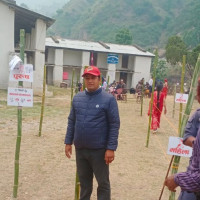- Saturday, 27 April 2024
Cultural Exchanges Across The Himalayas
This Spring Festival, China held its largest-ever series of activities to celebrate the festival in Nepal. A series of activities such as Chinese New Year parades, performances, New Year lantern exhibition, Sino-Nepali friendship soccer matches, Chinese New Year temple fairs, Chinese New Year festivals and customs were fully presented in Nepal, showcasing the profundity of the Chinese culture and reflecting the blending and dialogue of the Chinese and Nepali civilisations. The events attracted a large number of local people and Chinese and foreign tourists and won applause and cheers, and we all applauded for the Chinese New Year together.
This year coincides with the Year of the Dragon, a very special year. The dragon symbolises power, and we believe that China will achieve greater development and prosperity goals in the New Year. The two countries have a lot in common in terms of culture, history, geography and other aspects. This is a milestone in the history of cultural exchanges between China and Nepal.
In the Chinese traditional culture, the Spring Festival is regarded as one of the most important events, which not only carries thousands of years of history and culture, but also is a common emotional bond for Chinese diaspora around the world. It not only brings a strong festive atmosphere to the Chinese diaspora in Nepal, but also shows the unique charm of Chinese traditional culture to the Nepali people. With the deepening of China-Nepal relations, the two countries have been cooperating more and more closely in many fields such as politics, economy and culture. Such cultural exchange activities can not only enhance the mutual understanding and friendship between the two peoples, but also lay a solid foundation for public opinion for further development of China-Nepal relations.
The lofty Himalayas cannot isolate the civilisational exchange and dialogue between China and Nepal. For thousands of years, the exchanges and mutual understanding between China and Nepal have left countless good stories. In recent years, the civilisation dialogue and exchanges and mutual understanding between China and Nepal have taken on a new luster.
China and Nepal are linked by mountains and rivers and have been friendly for generations. The two neighbours have continuously exchanged views and learned from each other in the fields of religion, culture, art, sculpture and architecture. More than 1,600 years ago, the Chinese monk Fa Xian and the Nepali monk Foshan Tantra visited each other's countries and cooperated in the translation of the Buddhist classics that have been handed down to the present day. During the Tang Dynasty, the monk Xuanzang visited Lumbini, the birthplace of Siddhartha Gautam, and left precious written records. The eastward spread of Buddhism opened up a glorious period of civilisational exchanges between China and Nepal. For example, during the Yuan Dynasty, Anigo (known as Araniko in Nepal), a craftsman from Nepal, presided over the construction of many temples, pagodas and statues in China, including the Myo Ying (White Pagoda) Temple in Beijing, which became a landmark of cultural exchanges between China and Nepal. The successive struggles of one generation after another have created the everlasting China-Nepal friendship.
With the flow of time, the millennium seems to be just a fleeting moment. China and Nepal, two countries with a long history and splendid culture, stand on a new historical starting point. Humanity exchanges between the two countries have become increasingly close, adding color to the friendly relations between China and Nepal.
In the field of education, China and Nepal send students to each other, jointly promoting the sharing of educational resources and deepening academic research. More and more Nepali students are choosing to further their studies in China, where they learn advanced scientific and technological knowledge and experience the charm of Chinese education. Meanwhile, Chinese educational institutions and experts have also come to Nepal to provide support and assistance to local education.
China and Nepal have demonstrated their unique cultural charms by organising exhibitions, performances, art exchanges and other activities. Chinese calligraphy, painting, ceramics and other traditional culture and arts have attracted wide attention and praise in Nepal. Similarly, Nepal's religion, folklore, handicrafts and other cultures have been fully displayed and promoted in China. These activities have not only enriched the spiritual life of the people of the two countries, but also deepened the cultural identity and emotional ties between the two countries.
Cultural relics are carriers of civilisational exchange. In recent years, Nepal has held many exhibitions of Nirvar's fine thangkas in major cities in China, expanding the popularity of Nirvar's thangkas in China, and participated in activities such as the Chengdu 2023 World Expo for the protection and utilisation of cultural relics and monuments, so that more and more Chinese people can feel the unique Nepali culture. China also organised the "China Huayan Temple Collection of Han Dynasty Picture Stone Topographies Exhibition" and White Pagoda Cultural Week under the theme of Working Together to Let Chinese and Nepali Cultural Heritage Shine in Nepal to show the long history of humanistic exchanges and friendly contacts between China and Nepal. The White Pagoda Cultural Week Through the blending of history and modernity, the profound friendship between China and Nepal will continue to be passed on and developed.
Tourism is an important part of people level exchanges between the two countries. Chinese tourists have entered Nepal to experience this mysterious and beautiful country. Nepal's Himalayas, Fewa Lake and other natural landscapes have attracted the attention of countless Chinese tourists. Meanwhile, the people of Nepal also warmly welcome the arrival of Chinese tourists, and they make them feel the warmth of home with their enthusiasm and sincerity.
Standing on a new historical starting point, China and Nepal will continue to deepen humanistic exchanges and cooperation and jointly promote the further development of relations between the two countries. It is believed that in the near future, the friendship between the two peoples will be deep-rooted and flourishing.
Civilisations are colorful because of exchanges and enriched because of mutual understanding. By organising more influential cultural activities, the friendship between China and Nepal across the Himalayas will be pushed to new heights. This is not only a connection between the past and present and future, but also a bond between the people of the two countries, and a spiritual linkage between the two countries, where the flower of civilisation mingling between China and Nepal blooms in the Himalayas.
Civilisation and crystallisation of human wisdom have always blossomed its colorful charm in exchange and mutual learning. China and Nepal are separated by the magnificent Himalayas but this natural barrier has not been able to block the two countries' civilisational exchange and mutual learning. On the contrary, it is in this special geographic background that the civilisational exchanges between the two countries appear to be deepening further.
Under the witness of the Himalayas, the flower of civilisation blossomed between China and Nepal. Every petal of this flower represents the unique charm of the two civilisations and the fragrance of this flower conveys the deep friendship between the two peoples. Let us all look forward to this flower of civilisation blossoming into a more splendid glory in the days to come.
(The author is the Director of the Research Department on Xi Jinping Thought on Socialism with Chinese Characteristics for a New Era at Jiangsu Open University School of Marxism Studies.)
















